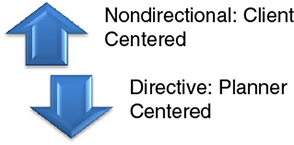CHAPTER 6Nondirective Communication
Imagine a continuum like the one shown in Figure 6.1. This is a visual representation of how those working in the counseling professions differentiate between a client and a helping professional (financial planner) being at the center of a discussion or meeting.1 On the top side of the continuum are clients. Communication techniques used here are intended to elicit attitudinal and behavioral information, and to promote open dialog and discussion between the client and financial planner. The bottom side of the continuum shows the financial planner–focused side of communication. As the focus of communication moves from top to bottom, the emphasis changes from client-centered discussion to communication that is directed by the adviser as a means of influencing behavior.

FIGURE 6.1 The Continuum of Communication
Here is an easy way to conceptualize what is going on in the figure: nondirectional communication is designed to encourage clients to talk and open up about their financial dreams, aspirations, and hoped-for life outcomes. Directive communication is much more focused on leading clients to a solution.
Much of what has been discussed in this book, up until this point, has dealt with nondirective communication strategies and approaches. For example, the use of silence and scaling questions exemplify nondirective communication methods. ...
Get Communication Essentials for Financial Planners now with the O’Reilly learning platform.
O’Reilly members experience books, live events, courses curated by job role, and more from O’Reilly and nearly 200 top publishers.

